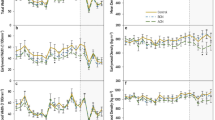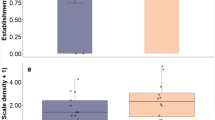Summary
A determination was made of the differences in the utilization of energy by laboratory reared larval Choristoneura fumiferana fed either balsam fir or white spruce foliage. This enabled us to quantitatively measure the quality of these foliages vis a vis the spruce budworm.
The larval strategy was to feed rapidly and develop quickly. Development time was longer on spruce than on fir. Total consumption was virtually identical on both foliage types though production was ca 20% greater on a white spruce diet. Calories/gram increased with insect development and with the development of balsam fir foliage but declined over time in white spruce. Assimilation efficiencies (A/C) were 33.9% to 40.2% while gross production efficiencies (P/C) were 9.5% to 13.3% and net production efficiencies (P/A) were 26.1% to 38.8%. The spruce fed insects gave higher values than those on fir, but all values were at the low end of the range for lepidopterous defoliators (possibly due to characteristics of conifer foliage).
The enhanced growth found in spruce fed larvae contrasts the relationship between balsam fir and high insect densities. This is discussed together with the influence of spruce budworm on forest composition and the possible competitive benefits of spruce budworm induced tree mortality.
Similar content being viewed by others
References
Agrell IPS, Lundquist AM (1974) Physiological and biochemical changes during insect development. In: Rockstein M (ed) The physiology of insecta, Vol. pp 159–233, Academic Press, New York London
Axelsson B, Lohm U, Nilsson A, Persson T, Tenow O (1975) Energetics of a larval population os Operophthera spp. (Lepidoptera, Geometridae) in Central Sweden during a fluctuating low. Zoon 3:71–84
Duncan A, Klekowski RZ (1975) Parameters of an energy budget. In: Groszinski W, Klekowski RZ and Duncan A (eds) Methods for ecological bioenergetics. p 97–148. Blackwell Scientific Publications, Oxford
Durzan DJ, Lopshanski SM (1968) Free and bound amino acids of spruce budworm larvae feeding on balsam fir and red and white spruce. J Insect Physiol 14:1485–1497
Ghent AW (1958) Studies of regeneration in forest stands devastated by the spruce budworm. II. Age, height, growth, and related studies of balsam fir seedlings. Forest Sci 4:135–146
Greenbank DO (1963) Host species and the spruce budworm. In: Morris RF (ed) The dynamics of epidemic spruce budworm populations. Mem Ent Soc Can No 31:219–223
Hagvar S (1975) Energy budget and growth during development of Melasoma collaris (Coleoptera). Oikos 26:140–146
Haukioja E, Haskala T (1975) Herbivore cycles and periodic outbreaks. Formulation of a general hypothesis. Rep Kevo Subarctic Res Stat 12:1–9
Heron RJ (1965) The role of chemotactic stimulii in the feeding behaviour of spruce budworm larvae on white spruce. Can J Zool 43:247–269
Hiratsuka E (1920) Recherches on the nutrition of the silk worm. Bull imp serie Exp Stn Tokyo 1:257–315
Kimmins JP (1971) Variations in the foliar amino acid composition of flowering and non-flowering balsam fir (Abies balsamea (L.) Mill.) and white spruce (Picea glauca (Moench) Voss) in relation to outbreaks of the spruce budworm (Choristoneura fumiferana) (Clem.). Can J Zool 49:1005–1011
Koller CN (1978) Energy budget for the spruce budworm, Choristoneura fumiferana, on balsam fir. M S thesis. University of Maine, Orono
Kogan M, Cope D (1974) Feeding and nutrition of insects associated with soybeans: III. Food intake and utilization in the soybean looper. Ann Entomol Soc Am 67:66–72
Larsson S, Tenow O (1979) Utilization of dry matter and bioelements in larvae of Neodiprion sertifer Geoffr (Hym Diprinidae) feeding on Scots Pine Pinus sylvestris L. Oecologia (Berl) 43:157–172
Latheef MA, Harcourt DG (1972) A quantitative study of food consumption, assimilation, and growth in Leptinotarsa decimilineata on two host plants. Can Ent 104:1271–1276
Mackey AP (1978) Growth and bioenergetics of the moth Cyclophragma leucosticta Grunberg. Oecologia (Berl) 32:367–376
Mathavan S, Bhaskaran R (1975) Food selection and utilization in a danid butterfly. Oecologia (Berl) 18:55–62
Mathavan S, Pandian TJ (1975) Effect of temperature on food utilization in the Monarch butterfly, Danaus chrysippus. Oikos 26:60–64
McKnight ME (1968) A literature review of the spruce, western, and 2-year cycle budworms, Choristoneura fumiferana, C. occidentalis, and C. biennis (Lepidoptera: Tortricidae). US for Serv Res Pap RM-44
Mukerji MK, Guppy JC (1970) A quantitative study of food consumption and growth in Pseudaletia unipuncta (Lepidoptera: Noctuidea). Can Ent 105:491–492
Pandian TJ, Delvi MR (1973) Energy extraction efficiency in some chosen insects. Oecologia (Berl) 13:397–401
Reichle DE, Corssley Jr DA (1967) Investigation on heterotrophic productivity in forest insect communities. In: Petrusewicz K (ed) Secondary productivity of terrestrial ecosystems, p 563–588. Warszawa-Krakow. PWN
Schroeder L (1977) Energy, matter, and nitrogen utilization by larvae of the milkweed tiger moth Euchaetis egle. Oikos 28:27–31
Schroeder L (1973) Energy budget of the larvae of the moth Pachyshinx modesta. Oikos 24:278–281
Schroeder L (1972) Energy budget of cecropia moth Platysamia cecropia fed lilac leaves. Ann Entomol Soc Am 65:367–372
Shaw GG, Little CHA (1974) Natural variation in balsam fir folia components of dietary importance to spruce budworm. Can J For Res 7:47–53
Swaine JM, Craighead FC, Bailey IW (1924) Studies on the spruce budworm (Cacoecia fumiferana Clem.). Ottawa: Can Dep Agr Bull 37
Weigert RG (1965) Intraspecific variation in calories/g of meadow spittlebugs (Phileanus spumarius L.). Bioscience 15:543–545
White TRC (1968) The importance of a relative shortage of food in animal ecology. Oecologia (Berl) 33:71–86
Zeuthen E (1953) O2 uptake as related to size of organisms. Quart Rev Biol 28:1–12
Author information
Authors and Affiliations
Additional information
Parts of this paper appeared in a Master's thesis (Koller 1978) submitted to the University of Maine
Rights and permissions
About this article
Cite this article
Noah Koller, C., Leonard, D.E. Comparison of energy budgets for spruce budworm Choristoneura fumiferana (Clemens) on balsam fir and white spruce. Oecologia 49, 14–20 (1981). https://doi.org/10.1007/BF00376892
Received:
Issue Date:
DOI: https://doi.org/10.1007/BF00376892




